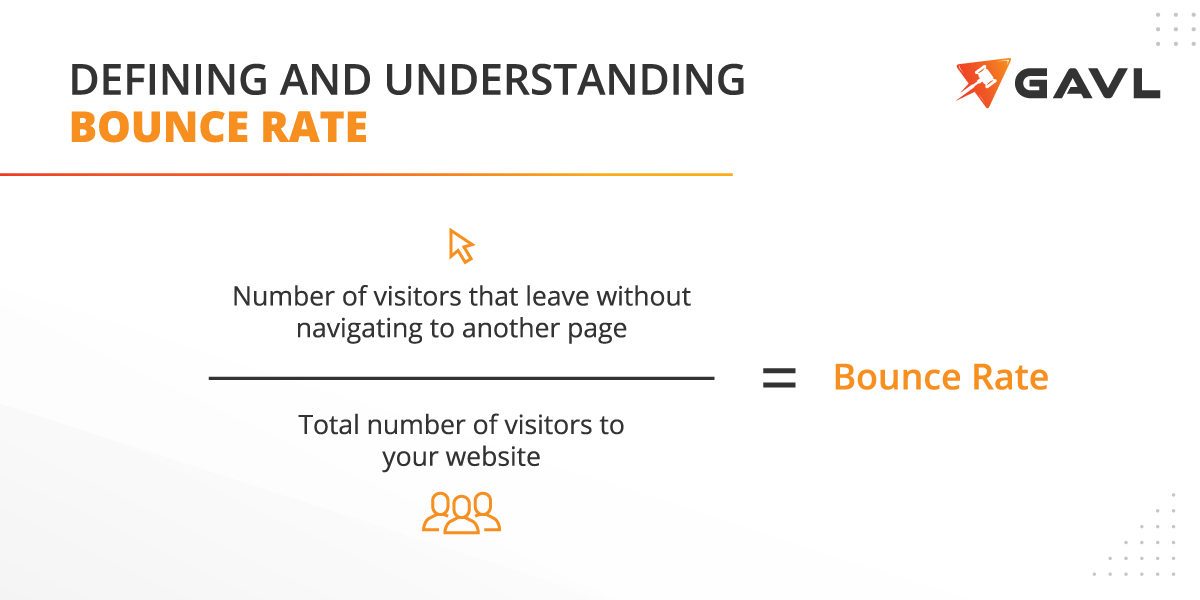Why Your Law Firm’s High Bounce Rate Isn’t Always Bad
Your website has a professional design, its load times are great, and the content is top-quality. So why are people still clicking away? If your bounce rate is higher than you’d like it to be, we want to put your mind at ease. Let’s get into why your law firm’s high bounce rate isn’t always bad and what it could be trying to tell you.
Key Takeaways
- Bounce rate is just one metric among dozens of others.
- Your site won’t be penalized in the rankings for a high bounce rate.
- A higher bounce rate can (sometimes) be a sign that you’re doing everything right.
Defining Bounce Rate
Bounce rate is the percentage of visitors to your website that land on or open a page and then leave. This percentage is calculated by dividing the number of single-page sessions by the total number of sessions.
If we’re thinking of bounce rate as a math equation, it would look like this:
If a visitor lands on your website and clicks through to another page, they won’t count as a “bounce.”
Are Bounce Rates a Ranking Factor for Google? Sorting Fact from Fiction
Fact: Bounce rates can tell us something about the performance and health of a website’s pages.
Fiction: Bounce rate is a definitive ranking factor for Google’s search engine results page.
Every In-Between: Bounce rates may have a correlation to rankings (but it’s complicated).
Google maintains a stance that bounce rate is not a ranking factor for showing up on the search engine results page (SERP). But just because Google doesn’t use bounce rate as a factor for who does (and who doesn’t) show up on the SERP doesn’t mean that there isn’t a correlation between the two. And, the correlation can be either positive or negative.
Because in all things search engine optimization, the impact on your site and rankings is highly contingent upon the unique factors of your site.
Let’s think about two possible reasons for a person to land on a website page and then click away:
- I found the information I was looking for, and I don’t need anything else.
- I couldn’t find the information I was looking for, and I don’t think I’ll find it on this site.
For some websites, a high bounce rate could be an indication of poor-quality content or black hat SEO techniques. In this situation, it’s not the high bounce rate that’s causing low rankings; it’s the website itself.
For other websites, a high bounce rate is a sign that visitors are getting everything they need from the page that they land on. For this scenario, the website’s quality is what’s boosting its rankings even with a higher bounce rate.
One of the most essential and key components of any search engine optimization strategy for law firms is to create high-quality content that aligns with search intent. Even Google explicitly states that it rewards “original, helpful content created for people in search results.”
This means that if you’ve done your job well, your website visitors won’t need to click two, three, or four pages deep to find the help they’re looking for.
When a High Bounce Rate Isn’t Bad (And Is Actually Good!)
Let’s take the example of a practice area page for a car accident lawyer in Williamsport, PA. Say someone was hit by another driver as they proceeded through a green light at an intersection. They get medical care, file a police report, and then go home, where they search for car crash lawyers in the Williamsport area.
They land on a practice area page for a Williamsport car accident attorney. On that page, they find information about filing deadlines, crash liability, different types of compensation, and the law firm’s phone number. They enter the number into their phone, hit “dial,” and close the webpage. Or they tap on the website’s clickable phone number and are automatically redirected to the app used for making calls.
That visit landed the lawyer a client, but it also counted as a bounce.
We have two main goals for your website. Have visitors:
- Fill out your online form.
- Call your law office.
So how do we tell when your bounce rate is low but it’s actually a good thing? GAVL Marketing uses a variety of tracking metrics to figure out where your clients are finding you—even if it’s a phone call. Using CallRail, we can tell whether a client called you directly, through the clickable button on your website, or via a social media button.
A high call rate from your website’s button paired with a high bounce rate tells a fuller and more accurate story than just looking at the bounce rate alone.
What Your Law Firm’s Bounce Rate Is Telling You
This is where things get a little complicated. Like with almost all things SEO, if you were to ask, “What does my law firm’s bounce rate mean?” the answer would be, “It depends.”
If you have a high bounce rate, few people filling out your online contact form, and little to no phone calls, it could be a sign that there’s a need for improvement. The content on your practice area pages might need to be updated, or website loading speeds may need to be improved.
But if your bounce rate is high and you’re still receiving a steady stream of contact from potential clients, it could be a very good sign that your website is informative, high-quality, and expertly matching the search intent of your potential clients.
Take Your Bounce Rate with a Grain of Salt
If you see that your website has a high bounce rate, don’t panic! You need to evaluate your bounce rate in conjunction with other important factors, including how many visitors fill out your online form or call your office.
So don’t get bogged down with the details. View your bounce rate in the context of an ecosystem—it’s just one of several SEO metrics that GAVL Marketing uses to evaluate a website’s health.
Come see us at these events.

OAJ Annual Convention 2024
GAVL is proudly exhibiting at the Ohio Association for Justice Annual Convention 2024.

Society of Women Trial Lawyers Annual Conference 2024
GAVL is excited to attend the Society of Women Trial Lawyers Annual Conference 2024!

Injury Board Pathfinder 2024
GAVL will be attending the Injury Board Pathfinder 2024 seminar!

